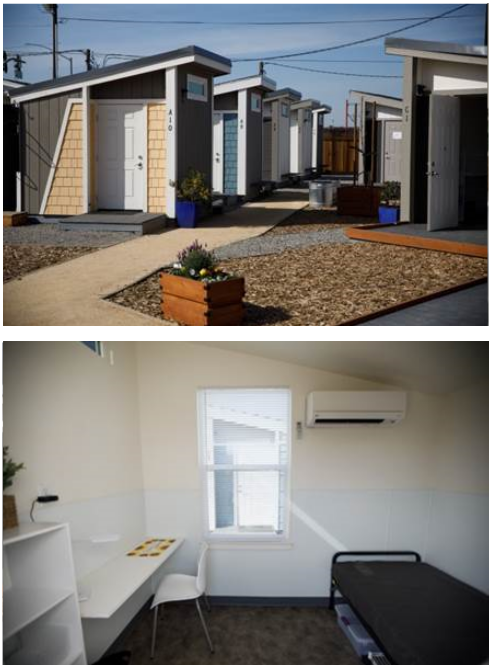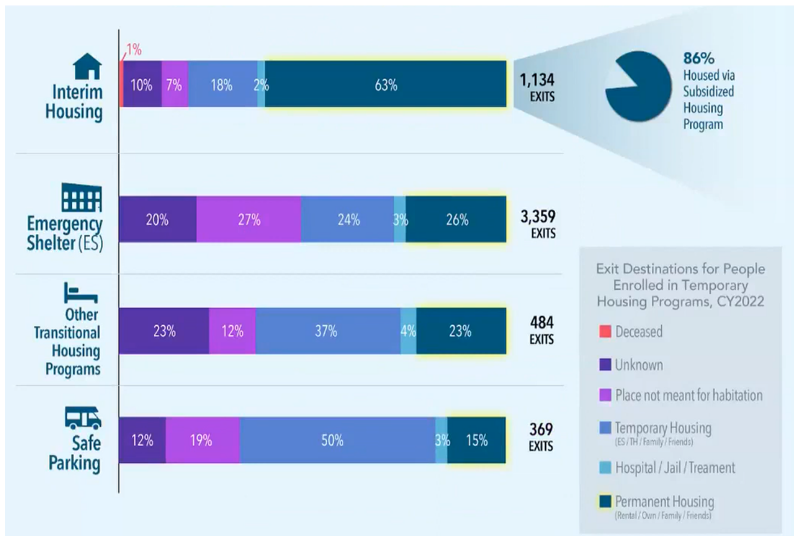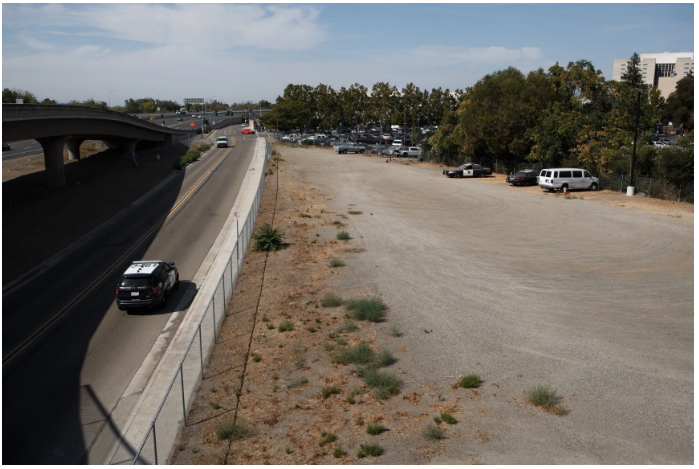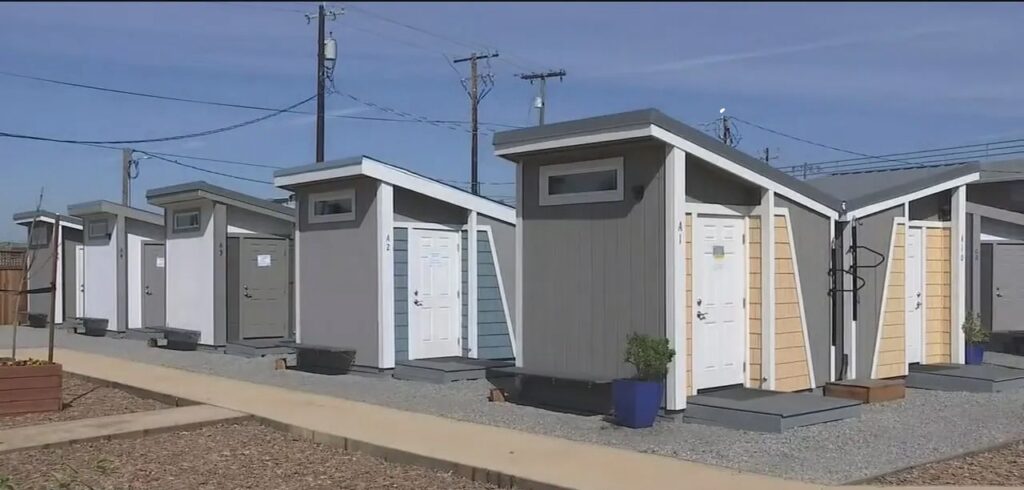Our communities are experiencing a homelessness crisis, which is a symptom of an overwhelming shortage of homes people can afford. Interim housing is a shelter innovation that provides an alternative to congregate shelters, the older open bunk rooms, where residents are required to leave during the day, and an important part of the continuum of response to homelessness.
What is interim shelter?

Interim shelter units, sometimes called interim temporary housing or emergency interim housing, can take many forms. These include motel conversions, tiny home sites, and prefabricated modular units. Typically, each person, couple, or family has their own private room with a locking door and can stay at the site for 2-6 months. Unlike most congregate shelters, residents are able to remain on-site during the day. Rooms generally provide beds, a desk or table, storage for belongings, light, and electrical outlets. Often, amenities such as bathrooms, a kitchen and dining area, and laundry facility are communal, and shared by all residents. At some sites, individual rooms have a private bathroom and/or kitchenette, and these units cost more to construct. Where available, private restrooms in units offer more independence, especially for the elderly and disabled, rather than community restrooms that can be more difficult to access.
How does interim shelter work?
Interim shelter units provide people experiencing homelessness a short-term opportunity to get out of the elements and stabilize their lives as they transition into permanent homes. They offer more privacy, safety, and stability than unsheltered homelessness or a traditional congregate shelter. Interim shelter sites generally offer services, such as job placement, mental health counseling, life skills training, and assistance applying for permanent housing, which support residents as they work toward a move to a permanent, stable home they can afford. For many residents, interim shelter units also provide a chance to recover from the trauma of living unsheltered. During the Covid-19 pandemic, the use of interim shelter units accelerated rapidly, as they provide more protection for medically vulnerable unhoused residents than a traditional congregate shelter.
How effective is interim shelter at helping people move to permanent housing?

Interim shelter is an important new tool, but only works when there are enough affordable permanent homes for people to move into. In San Jose, about half of the people who stay in interim shelter units leave for permanent housing. More than 85% of those transitioning from interim to permanent housing do so with the support of subsidized housing. Solving the homelessness crisis requires a comprehensive approach that includes both emergency interim housing and permanent affordable housing. The chart shows progress from Jan. 1, 2020 – Dec. 31, 2022 (Destination: Home)
Do interim shelter units cost less than permanent affordable housing?
Affordable and permanent supportive housing is a significantly more efficient investment for local cities than interim shelter units. Every dollar the city provides for permanent affordable housing leverages three to four dollars in additional public and private investment, making funding affordable housing less expensive and providing a long-term asset. Permanent affordable housing is built and financed to be self-sustaining for at least 55 years and is able to serve future generations. In contrast, the useful life of an interim structure can be as short as seven years.
One-time versus ongoing costs
Interim shelters also require significant ongoing funding for maintenance and operating costs. According to a City of San Jose analysis of the fiscal sustainability of interim housing operations, the interim units already in place or expected to be approved by the City of San Jose will cost more than $380,000 per unit to operate over the next 7 years (an average operating cost of more than $43,000 per unit, per year). In December of 2022, the City of San Jose funded four permanent affordable housing developments at an average cost of $116,435 per apartment, the amount needed to close the funding gap after state and federal investments. Since many of the affordable apartments were designed for families, this worked out to $65,689 per bedroom. The City’s one-time investment netted each bedroom of permanent affordable housing for less than the cost just to operate an interim unit for 2 years.
Additional challenges

Although a real improvement over unsheltered homelessness or congregate shelters, interim housing also faces challenges. Community opposition based on fear, misconceptions, and harmful stereotypes of people experiencing homelessness makes it difficult for local jurisdictions to win approval for interim shelter sites. As a result, interim housing communities are often located on public land beside freeway onramps, beneath overpasses, and in parking lots, where residents are exposed to noise and pollution and are sometimes far from jobs or outside services.
This image shows an overflow parking lot across the street from the San Jose Police Department, a site where the city intends to build a new interim shelter site for homeless residents living in and around Guadalupe River Park. (Dai Sugano/Bay Area News Group)

